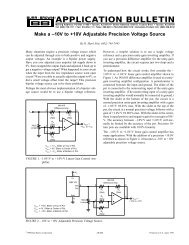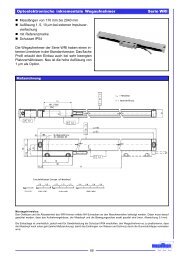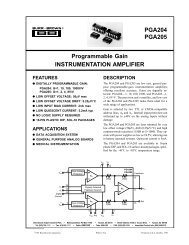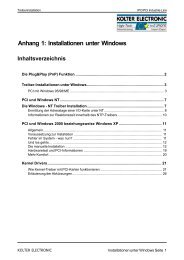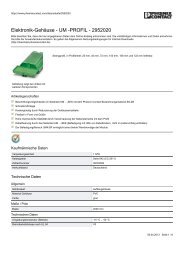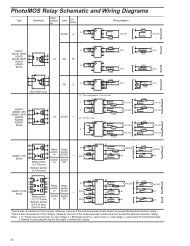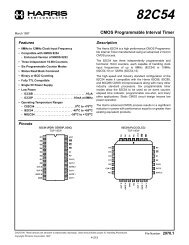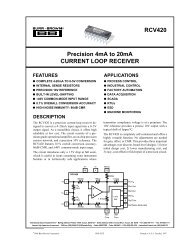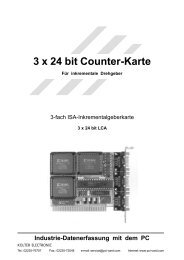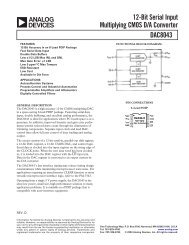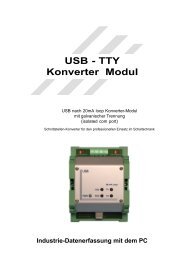OPA130 OPA2130 OPA4130 Low Power, Precision FET-INPUT ...
OPA130 OPA2130 OPA4130 Low Power, Precision FET-INPUT ...
OPA130 OPA2130 OPA4130 Low Power, Precision FET-INPUT ...
- No tags were found...
You also want an ePaper? Increase the reach of your titles
YUMPU automatically turns print PDFs into web optimized ePapers that Google loves.
SPECIFICATIONSAt T A = +25°C, V S = ±15V, and R L = 10kΩ, unless otherwise noted.<strong>OPA130</strong>PA, UA<strong>OPA2130</strong>PA, UA<strong>OPA4130</strong>PA, UAPARAMETER CONDITION MIN TYP MAX UNITSOFFSET VOLTAGEInput Offset Voltage ±0.2 ±1 mVvs Temperature (1) Operating Temperature Range ±2 ±10 µV/°Cvs <strong>Power</strong> Supply V S = ±2.25V to ±18V 2 20 µV/VChannel Separation (dual and quad) 0.3 µV/V<strong>INPUT</strong> BIAS CURRENT (2)Input Bias Current V CM = 0V +5 ±10 pAvs TemperatureSee Typical CurveInput Offset Current V CM = 0V ±2 ±20 pANOISEInput Voltage NoiseNoise Density, f = 10Hz 30 nV/√Hzf = 100Hz 18 nV/√Hzf = 1kHz 16 nV/√Hzf = 10kHz 16 nV/√HzCurrent Noise Density, f = 1kHz 4 fA/√Hz<strong>INPUT</strong> VOLTAGE RANGECommon-Mode Voltage Range, Positive (V+)–2 (V+)–1.5 VNegative (V–)+2 (V–)+1.2 VCommon-Mode Rejection V CM = –13V to +13V 90 105 dB<strong>INPUT</strong> IMPEDANCEDifferential 10 13 || 1 Ω || pFCommon-Mode V CM = –13V to +13V 10 13 || 3 Ω || pFOPEN-LOOP GAINOpen-loop Voltage Gain V O = –13.8V to +13V 120 135 dBR L = 2kΩ, V O = –13V to +12V 120 135 dBFREQUENCY RESPONSEGain-Bandwidth Product 1 MHzSlew Rate 2 V/µsSettling Time: 0.1% G = 1, 10V Step, C L = 100pF 5.5 µs0.01% G = 1, 10V Step, C L = 100pF 7 µsOverload Recovery Time G = 1, V IN = ±15V 2 µsTotal Harmonic Distortion + Noise 1kHz, G = 1, V O = 3.5Vrms 0.0003 %OUTPUTVoltage Output, Positive (V+)–2 (V+)–1.5 VNegative (V–)+1.2 (V–)+1 VPositive R L = 2kΩ (V+)–3 (V+)–2.5 VNegative R L = 2kΩ (V–)+2 (V–)+1.5 VShort-Circuit Current ±18 mACapacitive Load Drive (Stable Operation) 10 nFPOWER SUPPLYSpecified Operating Voltage ±15 VOperating Voltage Range ±2.25 ±18 VQuiescent Current (per amplifier) I O = 0 ±530 ±650 µATEMPERATURE RANGEOperating Range –40 +85 °CStorage –40 +125 °CThermal Resistance, θ JA8-Pin DIP 100 °C/WSO-8 Surface-Mount 150 °C/W14-Pin DIP 80 °C/WSO-14 Surface-Mount 110 °C/WNOTES: (1) Guaranteed by wafer test. (2) High-speed test at T J = 25°C.The information provided herein is believed to be reliable; however, BURR-BROWN assumes no responsibility for inaccuracies or omissions. BURR-BROWN assumesno responsibility for the use of this information, and all use of such information shall be entirely at the user’s own risk. Prices and specifications are subject to changewithout notice. No patent rights or licenses to any of the circuits described herein are implied or granted to any third party. BURR-BROWN does not authorize or warrantany BURR-BROWN product for use in life support devices and/or systems.®<strong>OPA130</strong>, 2130, 41302
ABSOLUTE MAXIMUM RATINGSSupply Voltage, V+ to V– .................................................................... 36VInput Voltage .................................................... (V–) –0.7V to (V+) +0.7VOutput Short-Circuit (1) .............................................................. ContinuousOperating Temperature ................................................. –40°C to +125°CStorage Temperature ..................................................... –40°C to +125°CJunction Temperature ...................................................................... 150°CLead Temperature (soldering, 10s) ................................................. 300°CNOTE: (1) Short-circuit to ground, one amplifier per package.PACKAGE/ORDERING INFORMATIONPACKAGEDRAWING TEMPERATUREPRODUCT PACKAGE NUMBER (1) RANGEELECTROSTATICDISCHARGE SENSITIVITYThis integrated circuit can be damaged by ESD. Burr-Brownrecommends that all integrated circuits be handled withappropriate precautions. Failure to observe proper handlingand installation procedures can cause damage.ESD damage can range from subtle performance degradationto complete device failure. <strong>Precision</strong> integrated circuitsmay be more susceptible to damage because very smallparametric changes could cause the device not to meet itspublished specifications.Single<strong>OPA130</strong>PA 8-Pin Plastic DIP 006 –40°C to +85°C<strong>OPA130</strong>UA SO-8 Surface-Mount 182 –40°C to +85°CDual<strong>OPA2130</strong>PA 8-Pin Plastic DIP 006 –40°C to +85°C<strong>OPA2130</strong>UA SO-8 Surface-Mount 182 –40°C to +85°CQuad<strong>OPA4130</strong>PA 14-Pin Plastic DIP 010 –40°C to +85°C<strong>OPA4130</strong>UA SO-14 Surface-Mount 235 –40°C to +85°CNOTE: (1) For detailed drawing and dimension table, please see end of datasheet, or Appendix C of Burr-Brown IC Data Book.3 <strong>OPA130</strong>, 2130, 4130®
TYPICAL PERFORMANCE CURVESAt T A = +25°C, V S = ±15V, and R L = 10kΩ, unless otherwise noted.Voltage Gain (dB)120100806040200–201OPEN-LOOP GAIN/PHASE vs FREQUENCY0C L= 100pFφG10 100 1k 10k 100k 1M 10MFrequency (Hz)–45–90–135–180Phase Shift (°)PSR, CMR (dB)120110100908070605040302010POWER SUPPLY AND COMMON-MODE REJECTIONvs FREQUENCY+PSRCMR–PSR010 100 1k 10k 100k 1MFrequency (Hz)1k<strong>INPUT</strong> VOLTAGE AND CURRENT NOISESPECTRAL DENSITY vs FREQUENCY1k160CHANNEL SEPARATION vs FREQUENCYVoltage Noise (nV/√Hz)1001011100Voltage Noise10Current Noise110 100 1k 10k 100k 1MFrequency (Hz)Current Noise (fA/√Hz)Channel Separation (dB)140120Dual and quad devices.G = 1, all channels.100Quad measured channelA to D or B to C—other R L = 10kΩcombinations yield improvedrejection.8010 100 1k 10k 100kFrequency (Hz)Input Bias and Input Offset Current (pA)10k1k1001010.1<strong>INPUT</strong> BIAS AND <strong>INPUT</strong> OFFSET CURRENTvs TEMPERATUREV CM = 0V0.01–75 –50 –25 0 25 50 75 100 125I BAmbient Temperature (°C)I OSInput Bias Current (pA)105<strong>INPUT</strong> BIAS CURRENTvs <strong>INPUT</strong> COMMON-MODE VOLTAGE0–15 –10 –5 0 5 10 15Common-Mode Voltage (V)®<strong>OPA130</strong>, 2130, 41304
TYPICAL PERFORMANCE CURVES (CONT)At T A = +25°C, V S = ±15V, and R L = 10kΩ, unless otherwise noted.140A OL , CMR, PSR vs TEMPERATURE0.65QUIESCENT CURRENT AND SHORT-CIRCUIT CURRENTvs TEMPERATURE40A OL , CMR, PSR (dB)130120110CMRPSROpen-LoopGain100–75 –50 –25 0 25 50 75 100 125Ambient Temperature (°C)Quiescent Current Per Amp (mA)0.600.550.500.450.40+I SC–I SCI Q0.3510–75 –50 –25 0 25 50 75 100 125Temperature (°C)3530252015Short-Circuit Current (mA)15OFFSET VOLTAGEPRODUCTION DISTRIBUTION20OFFSET VOLTAGE DRIFTPRODUCTION DISTRIBUTION18Percent of Amplifiers (%)105Percent of Amplifiers (%)16141210864200–700–600–500–400–300–200–10001002003004005006007000.000.501.001.502.002.503.003.504.004.505.005.506.006.507.007.508.00Offset Voltage (µV)Offset Voltage Drift (µV/°C)0.1TOTAL HARMONIC DISTORTION + NOISEvs FREQUENCY30MAXIMUM OUTPUT VOLTAGEvs FREQUENCYTHD + Noise (%)0.010.001G = +1G = +10R L = 10kΩR L= 2kΩOutput Voltage (Vp-p)252015105V S = ±5VV S = ±2.25VV S = ±15VMaximum output voltagewithout slew-rate induceddistortion0.0001100 1k 10k 100kFrequency (Hz)010k100kFrequency (Hz)1M5 <strong>OPA130</strong>, 2130, 4130®
TYPICAL PERFORMANCE CURVES (CONT)At T A = +25°C, V S = ±15V, and R L = 10kΩ, unless otherwise noted.SMALL-SIGNAL STEP RESPONSEG =1, C L = 100pFSMALL-SIGNAL STEP RESPONSEG = 1, C L = 1000pF50mV/div50mV/div500ns/div5µs/divLARGE-SIGNAL STEP RESPONSEG = 1, C L = 100pF100SETTLING TIME vs GAIN0.01%5V/divSettling Time (µs)100.1%5µs/div1±1 ±10 ±100Gain (V/V)Output Voltage Swing (V)151413121110–10–11–12–13–14–15OUTPUT VOLTAGE SWING vs OUTPUT CURRENT+125°C+125°C+25°C+25°C–55°C+85°C–55°C0 ±5 ±10 ±15 ±20Output Current (mA)Overshoot (%)8070605040302010SMALL-SIGNAL OVERSHOOTvs LOAD CAPACITANCEG = +1G = –1G = ±5010pF 100pF 1nF 10nF 100nFLoad Capacitance (F)®<strong>OPA130</strong>, 2130, 41306
APPLICATIONS INFORMATION<strong>OPA130</strong> series op amps are unity-gain stable and suitablefor a wide range of general-purpose applications. <strong>Power</strong>supply pins should be bypassed with 10nF ceramic capacitorsor larger.<strong>OPA130</strong> op amps are free from unexpected output phasereversalcommon with <strong>FET</strong> op amps. Many <strong>FET</strong>-input opamps exhibit phase-reversal of the output when the inputcommon-mode voltage range is exceeded. This can occur involtage-follower circuits, causing serious problems incontrol loop applications. <strong>OPA130</strong> series op amps are freefrom this undesirable behavior. All circuitry is completelyindependent in dual and quad versions, assuring normalbehavior when one amplifier in a package is overdriven orshort-circuited.OPERATING VOLTAGE<strong>OPA130</strong> series op amps operate with power supplies from±2.25V to ±18V with excellent performance. Althoughspecifications are production tested with ±15V supplies,most behavior remains unchanged throughout the fulloperating voltage range. Parameters which vary significantlywith operating voltage are shown in the typicalperformance curves.OFFSET VOLTAGE TRIMOffset voltage of <strong>OPA130</strong> series amplifiers is laser trimmedand usually requires no user adjustment. The <strong>OPA130</strong>(single op amp version) provides offset voltage trim connectionson pins 1 and 5. Offset voltage can be adjusted byconnecting a potentiometer as shown in Figure 1. Thisadjustment should be used only to null the offset of the opamp, not to adjust system offset or offset produced by thesignal source. Nulling offset that is not produced by theamplifier will change the offset voltage drift behavior ofthe op amp.10nF2310nF7V+V–100kΩ<strong>OPA130</strong>41Trim Range: ±5mV typ56<strong>OPA130</strong> single op amp only.Use offset adjust pins only to nulloffset voltage of op amp—see text.FIGURE 1. <strong>OPA130</strong> Offset Voltage Trim Circuit.<strong>INPUT</strong> BIAS CURRENTThe input bias current is approximately 5pA at room temperatureand increases with temperature as shown in thetypical performance curve “Input Bias Current vs Temperature.”Input stage cascode circuitry assures that the input biascurrent remains virtually unchanged throughout the fullinput common-mode range of the <strong>OPA130</strong>. See the typicalperformance curve “Input Bias Current vs Common-ModeVoltage.”7 <strong>OPA130</strong>, 2130, 4130®



